
ERIC KRAUSE
In
business since 1996
- © Krause House
Info-Research Solutions -
DOUBLE COURT INDOOR TENNIS FACILITY PROPOSAL
JANUARY 21, 2015 UPDATE
(B) 2015 RESEARCH
DECEMBER 21, 2015
Hello All:
Yesterday, Sunday, December 21, [2014] at the outdoor Cromarty Tennis Club, there was held a meeting to discuss the exciting possibility that the operation of a permanent indoor tennis facility might be just around the corner here in Sydney. In attendance was a large contingent of members from the non-profit Cromarty Tennis Club as well as representatives from the executive of the charity Cromarty Community Indoor Tennis Centre.
Dr. Sivakumar Annamalai, in his presentation, gave his strong support for a permanent indoor tennis facility which he wants to see operating as soon as possible here in Sydney. He then discussed in detail a number of scenarios that he thought should be pursued, and several of us in attendance immediately agreed to help him in identifying the best way to achieve this goal - whether through the purchase, lease, or construction of a facility.
Siva wants to give back to society, and he is willing to provide meaningful financial support to achieve his vision.
A second meeting has been scheduled for January 9, at 6:30 PM, and its location and other details will be revealed in my next e-mail.
Naturally, Dr. Annamalai would appreciate any ideas that we could explore prior to the next meeting, and if you could pass them onto me, I will pass them onto him.
Our preference is for a 2-court indoor facility, but one with only one court is still a possibility. Ideally, a single court should measure 60 feet x 120 feet clear, with say 38-40 feet clear of ceiling height, but these dimension can be reduced somewhat in all directions.
We are determined to pull off this project relatively quickly.
Thanks for reading this e-mail,
Eric
---------------------
JANUARY 12, 2015
OLYMPIA TWO COURT STRUCTURE
NOTE:
The cost of this structure does not include taxes,
heating, insulation, lighting, conversion to CND dollars, erection cost, frost
walls, doors, courts, etc.
Click Here: Preliminary Drawings
---------------------
Quote
---------------------
Renderings
(B) AUGUST 20, 2010 RESEARCH
(A) TWO POSSIBLE BUILDING CONFIGURATIONS
(1) Side by Side Tennis Courts (The Building Must Then Measure 120' x 120' or Greater)
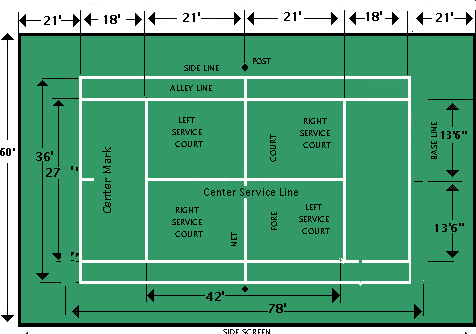
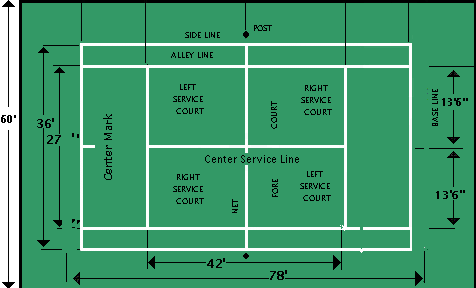
<----------------------------------------- 120'----------------------------------------->
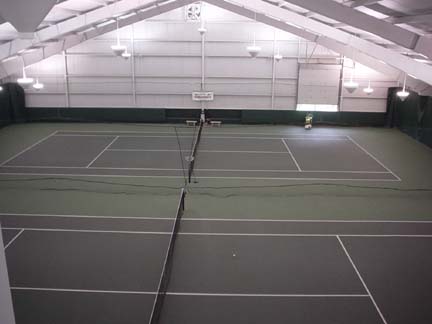
(2) End to End Tennis Courts (Building Must Then Measure 60' x 240' or Greater)
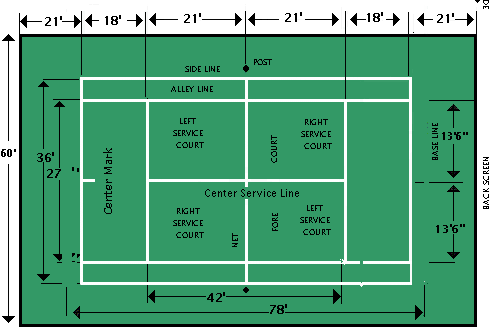
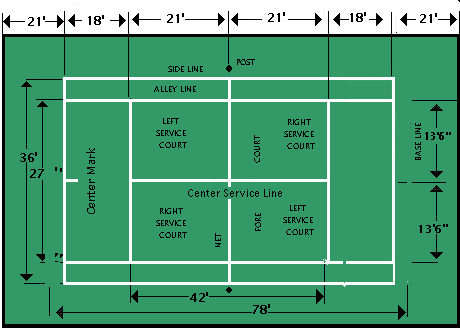
<----------------------------------------------------------------------------------------------240'
----------------------------------------------------------------------------------------->
Floor area - clear span
Minimum of 24 foot clear height along the length and width of each court
Minimum 39 feet clear height above the center service line of each court
12-lamp Courtlite Indirect "green" T5 fluorescent blue light technology units (Three Phase Wiring) - The units in total must produce a maximum of 10,844 watts for exhibition play but be by-level wired so that 1/2 of the lamps can be turned off for recreational play and educational classes
The Courtlite indirect lighting system will require a vapour barrier that must be highly reflective reinforced white fabric which is resistant to ball puncture - Lamtec® Gymguard or equal for wall and ceiling applications which offers a smooth, bright white finish and a continuous vapor barrier is preferred.
A 55 F. degrees [12.7 degrees C] inside winter temperature is required for court play
Wheelchair accessible building
(C) GENERAL COURT REQUIREMENTS
Two cushioned tennis courts (a six layer cushioned system is preferred) upon an asphalt base are preferred to either Hart-Tru (clay) or standard acrylic surfaced courts (cheapest to construct)
Singles and doubles nets, centre posts, end or side curtains, and related furnishings.
(D) COMMUNITY BENEFIT/IMPACT
Built exclusively for the benefit of the public at large, and serving as a hub facility for the entire CBRM, the facility will also place a particular focus on the young, the old, the challenged, and those unfamiliar with the game of tennis. It will provide a summer/winter, healthy lifestyle playing venue for all levels and ages of tennis players, from novice through seasoned. It will encourage high public user participation rates through an affordable hourly rate - first come, first serve - and educational group clinics. It will stress that its state-of-the art cushioned court is exceptionally physically friendly, to draw in the older and challenged player who might hesitate to participate otherwise.
The facility will stress public instruction, at both an hourly and clinic level. At the hourly level, facility trained local staff will provide tennis advice, knowledge, practical tips, and even racquets upon the asking, at no additional charge.
In addition, the facility will target the younger public, through assorted winter and summer group clinics. In particular, the facility will concentrate on winter school, after school, and specialized junior development programmes based on Tennis Canada training, instructional, and skills upgrading criteria. Winter coaching clinics will be another priority, as would other community group initiatives, such as wheelchair and mixed senior (plus 55) play.
(E) NEEDS ASSESSMENT
As Cape Breton’s first indoor facility designed only for tennis, the facility will increase the physical activity and overall well-being and health of an island population within an unique setting hitherto only available on the mainland and elsewhere in Canada. Thus, while inclusive of all, yet as well focusing on the young, the old, and the challenged, the facility will also emphasize, in its design and programming, an enhanced accessibility (including wheelchair access).
The facility will stress physical activity amongst a client base clearly in need of public direction, will mobilize a community looking desperately for increased infrastructure capacity, provide a safe environment in an ever dangerous world, increase public awareness of the need for physical activity, and provide proof that its programming has beneficial personal and community outcomes.
In the past, arrangements for winter tennis - be it by the outdoor Cromarty Tennis Club, or private members initiative - whether in warehouses in Sydport or on the North Side, or at CBU, drew substantive numbers of players of all ages. Willing as they were to play in makeshift surroundings, these locations represented a clear need and crying out for a proper facility. In particular, they speak to an aging Cape Breton population seeking physical experience as a significant life choice on an island where such choices are limited, relative to other Canadian places.
Finally, the facility would be "adding to" the existing recreational infrastructure capacity of CBRM. There are numerous non-profit and municipal run outdoor summer tennis facilities in the CBRM, and it would be the first indoor tennis facility (as well as a year-round operation) in the CBRM and indeed on the Island of Cape Breton.
(F) LONG TERM SUSTAINABILITY
The facility could draw upon the experience, proven volunteerism and participation of the outdoor Cromarty Tennis Club which has uninterrupted success in Sydney since 1902. Their list of accomplishments, which are legendary, has included a strong, sustainable annual, summer outdoor after-school and junior programme. They also support a growing retiree and friends programme that encourages outdoor tennis play throughout the year (including the winter months when possible) for the older player. Clearly the facility will be a valuable asset to which the memberships of the outdoor Cromarty Tennis Club and other CBRM tennis clubs will turn, particularly during the winter and inclement days.
The Cape-Breton-Victoria Regional School Board has developed a very successful healthy life styles programme with Ski Ben Eoin that is linked to its physical education curriculum, in which they stress it important that children participate. This facility could receive the same treatment once its structured programme was in place. This is because it will stress the same goals and even more, and also is inclusive of physically challenged children. As at Ben Eoin, there would be a cost recovery charge-back to the participant.
Since the design of the facility would meet Tennis Canada standards, it could encourage exhibition matches involving professionals in support of its charity programmes. For example, the "Raising a Racquet for Kids" is an annual fundraiser where for example current world doubles #1 player, Daniel Nestor & rising Canadian star, 20 year old Peter Polansky have appeared.
Another example is where Tennis Canada is mandated “to lead the growth, promotion and showcasing of the sport of wheelchair tennis in Canada, build a system that helps produce world class players, and foster the pursuit of excellence for all. “ As a consequence, Tennis Canada recognizes the impact a tennis chair has on the enjoyment of challenged players and on the general progression in the sport, and thus has a lending programme to provide quality used tennis chairs to programmes such as here.
This facility would also be new, and comes with a number of long-term warranties. For example, the structure itself could come with 25 and 50-year warranties.
List of some community organizations (in addition to the general public) that will use the facility:
(1) Cromarty Tennis Club.
(2) Sydney River Tennis Club.
(3) Glace Bay Tennis Club.
(4) New Waterford Tennis Club.
(5) North Sydney Tennis Club.
(6) Cape-Breton-Victoria Regional School Board.
(7) Cape Breton Island Hoppers Volksmarch Club.
(8) The Community of Membertou
In other words, long term sustainability will not be a problem.